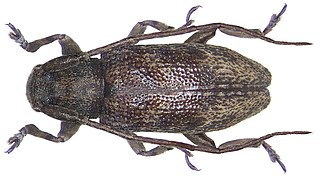
Womanism is a social theory based on the history and everyday experiences of black women. It seeks, according to womanist scholar Layli Maparyan (Phillips), to "restore the balance between people and the environment/nature and reconcil[e] human life with the spiritual dimension". Writer Alice Walker coined the term "womanist" in a short story, "Coming Apart", in 1979. Since Walker's initial use, the term has evolved to envelop varied, and often opposing, interpretations of concepts such as feminism, men, and blackness.

The Amazon weasel, also known as the tropical weasel, is a species of weasel native to South America. It was first identified from a museum specimen mislabelled as coming from Africa, hence the scientific name.

Voacangine is an alkaloid found predominantly in the root bark of the Voacanga africana tree, as well as in other plants such as Tabernanthe iboga, Tabernaemontana africana, Trachelospermum jasminoides, Tabernaemontana divaricata and Ervatamia yunnanensis. It is an iboga alkaloid which commonly serves as a precursor for the semi-synthesis of ibogaine. It has been demonstrated in animals to have similar anti-addictive properties to ibogaine itself. It also potentiates the effects of barbiturates. Under UV-A and UV-B light its crystals fluoresce blue-green, and it is soluble in ethanol.

Kigelia is a genus of flowering plants in the family Bignoniaceae. The genus consists of only one species, Kigelia africana, which occurs throughout tropical Africa. The so-called sausage tree grows a poisonous fruit that is up to 60 cm long, weighs about 7 kg, and resembles a sausage in a casing.

Prunus africana, the African cherry, has a wide distribution in Africa, occurring in montane regions of central and southern Africa and on the islands of Bioko, São-Tomé, Grande Comore, and Madagascar. It can be found at 900–3,400 m (3,000–10,000 ft) above sea level. It is a canopy tree 30–40 m in height, and is the tallest member of Prunus. Large-diameter trees have impressive, spreading crowns. It requires a moist climate, 900–3,400 mm (35–130 in) annual rainfall, and is moderately frost-tolerant. P. africana appears to be a light-demanding, secondary-forest species.
Africana studies, black studies or Africology, in US education, is the multidisciplinary study of the histories, politics and cultures of peoples of African origin in both Africa and the African diaspora.
Africana: The Encyclopedia of the African and African-American Experience edited by Henry Louis Gates and Anthony Appiah is a compendium of Africana studies including African studies and the "Pan-African diaspora" inspired by W. E. B. Du Bois' project of an Encyclopedia Africana. Du Bois envisioned "an Encyclopedia Africana," which was to be "unashamedly Afro-Centric but not indifferent to the impact of the outside world."

Ropica Górna is a village in the administrative district of Gmina Sękowa, within Gorlice County, Lesser Poland Voivodeship, in southern Poland, close to the border with Slovakia. It lies approximately 4 kilometres (2 mi) east of Sękowa, 9 km (6 mi) south-east of Gorlice, and 108 km (67 mi) south-east of the regional capital Kraków.

The African bush elephant, also known as the African savanna elephant, is one of two living African elephant species. It is the largest living terrestrial animal, with bulls reaching a shoulder height of up to 3.96 m (13.0 ft) and a body mass of up to 10.4 t . It is distributed across 37 African countries and inhabits forests, grasslands and woodlands, wetlands and agricultural land. Since 2021, it has been listed as Endangered on the IUCN Red List. It is threatened foremost by habitat destruction, and in parts of its range also by poaching for meat and ivory. It is a social mammal, travelling in herds composed of cows and their offspring. Adult bulls usually live alone or in small bachelor groups. It is a herbivore, feeding on grasses, creepers, herbs, leaves, and bark.
"Africana womanism" is a term coined in the late 1980s by Clenora Hudson-Weems intended as an ideology applicable to all women of African descent. It is grounded in African culture and Afrocentrism and focuses on the experiences, struggles, needs, and desires of Africana women of the African diaspora. It distinguishes itself from feminism, or Alice Walker's womanism. Africana womanism pays more attention to and focuses more on the realities and the injustices in society in regard to race.
Bulaimu Muwanga Kibirige, commonly known as BMK, is a Ugandan businessman, entrepreneur, and hotel owner. According to a 2012 published report, he was one of the wealthiest people in Uganda.

The West Sudanian savanna is a tropical savanna ecoregion that extends across West Africa.

Ropica is a genus of beetles in the family Cerambycidae, containing the following species:
Ropica albomarmorata is a species of beetle in the family Cerambycidae. It was described by Breuning in 1939.
Ropica sumatrensis is a species of beetle in the family Cerambycidae. It was described by Breuning in 1939.
Ropica kaszabi is a species of beetle in the family Cerambycidae. It was described by Breuning in 1975.
Ropica sechellarum is a species of beetle in the family Cerambycidae. It was described by Breuning in 1957. It contains the subspecies Ropica sechellarum interruptefasciata and Ropica sechellarum sechellarum.
Ropica duboisi is a species of beetle in the family Cerambycidae. It was described by Fairmaire in 1850.
Ropica formosana is a species of beetle in the family Cerambycidae. It was described by Henry Walter Bates in 1866. It contains four subspecies, Ropica formosana formosana, Ropica formosana japonica, Ropica formosana nobuoi, and Ropica formosana tokaraensis.








